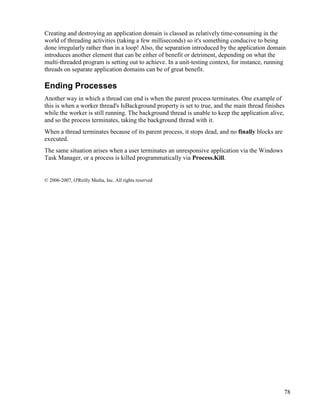This document provides an overview and introduction to threading in C#. It discusses key threading concepts such as threads versus processes, when to use threads, creating and starting threads, passing data to threads, naming threads, foreground and background threads, thread priority, exception handling, blocking, sleeping and spinning, joining threads, locking for thread safety, wait handles, synchronization contexts, and more advanced topics such as non-blocking synchronization, wait and pulse, suspend and resume, aborting threads, and ending application domains and processes. The document is presented as a multi-part guide to threading in C#, with examples provided throughout to illustrate the concepts.
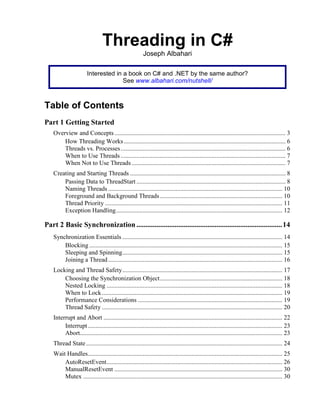


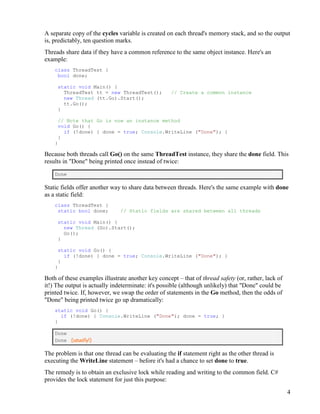
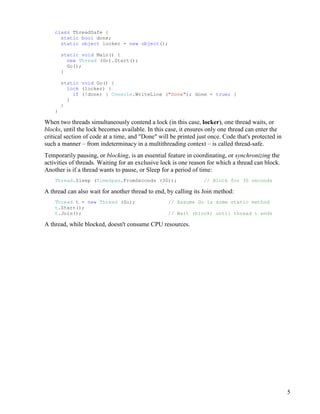
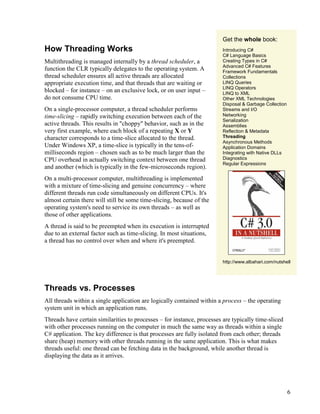

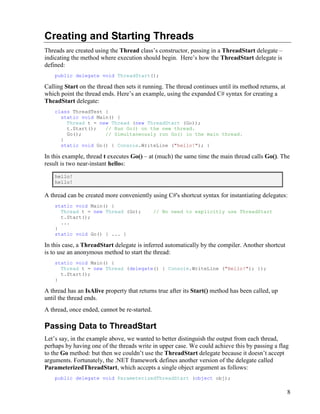
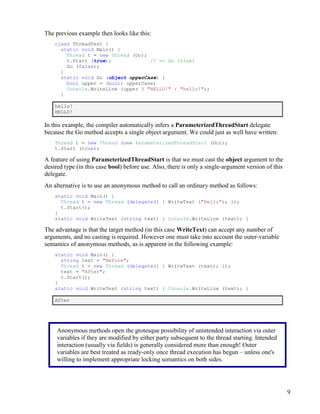
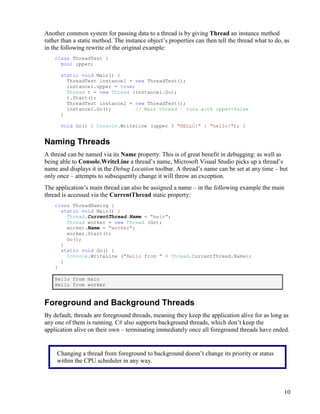
![11
A thread's IsBackground property controls its background status, as in the following example:
class PriorityTest {
static void Main (string[] args) {
Thread worker = new Thread (delegate() { Console.ReadLine(); });
if (args.Length > 0) worker.IsBackground = true;
worker.Start();
}
}
If the program is called with no arguments, the worker thread runs in its default foreground
mode, and will wait on the ReadLine statement, waiting for the user to hit Enter. Meanwhile,
the main thread exits, but the application keeps running because a foreground thread is still alive.
If on the other hand an argument is passed to Main(), the worker is assigned background status,
and the program exits almost immediately as the main thread ends – terminating the ReadLine.
When a background thread terminates in this manner, any finally blocks are circumvented. As
circumventing finally code is generally undesirable, it's good practice to explicitly wait for any
background worker threads to finish before exiting an application – perhaps with a timeout (this
is achieved by calling Thread.Join). If for some reason a renegade worker thread never finishes,
one can then attempt to abort it, and if that fails, abandon the thread, allowing it to die with the
process (logging the conundrum at this stage would also make sense!)
Having worker threads as background threads can then beneficial, for the very reason that it's
always possible to have the last say when it comes to ending the application. Consider the
alternative – foreground thread that won't die – preventing the application from exiting. An
abandoned foreground worker thread is particularly insidious with a Windows Forms application,
because the application will appear to exit when the main thread ends (at least to the user) but its
process will remain running. In the Windows Task Manager, it will have disappeared from the
Applications tab, although its executable filename still be visible in the Processes tab. Unless the
user explicitly locates and ends the task, it will continue to consume resources and perhaps
prevent a new instance of the application from starting or functioning properly.
Thread Priority
A thread’s Priority property determines how much execution time it gets relative to other active
threads in the same process, on the following scale:
enum ThreadPriority { Lowest, BelowNormal, Normal, AboveNormal, Highest }
This becomes relevant only when multiple threads are simultaneously active.
Setting a thread’s priority to high doesn’t mean it can perform real-time work, because it’s still
limited by the application’s process priority. To perform real-time work, the Process class in
System.Diagnostics must also be used to elevate the process priority as follows (I didn't tell you
how to do this):
Process.GetCurrentProcess().PriorityClass = ProcessPriorityClass.High;
A common cause for an application failing to exit properly is the presence of
“forgotten” foregrounds threads.](https://image.slidesharecdn.com/threadingincsharp-160921154623/85/Threading-in-c_sharp-11-320.jpg)
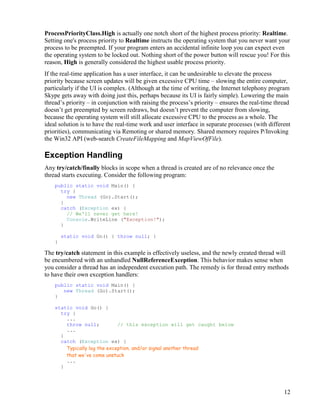
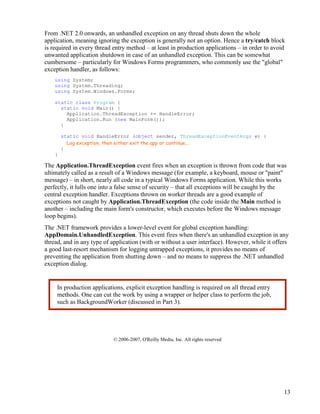
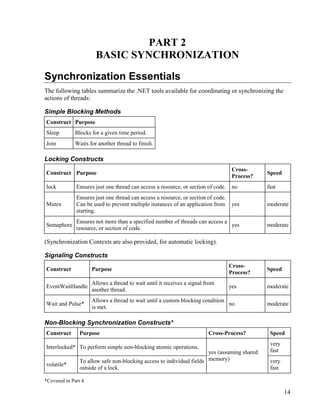
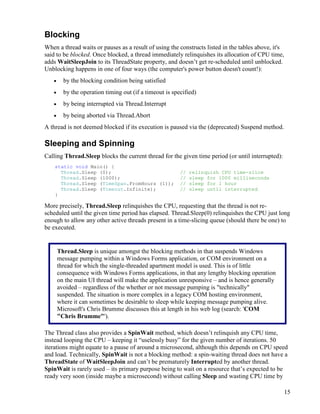
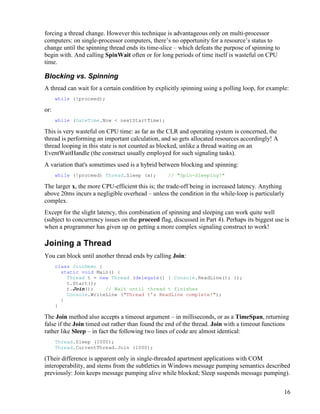
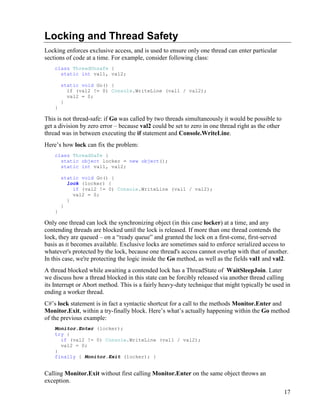


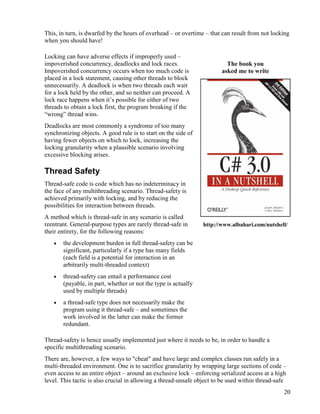
![21
code – and is valid providing the same exclusive lock is used to protect access to all properties,
methods and fields on the thread-unsafe object.
Another way to cheat is to minimize thread interaction by minimizing shared data. This is an
excellent approach and is used implicitly in "stateless" middle-tier application and web page
servers. Since multiple client requests can arrive simultaneously, each request comes in on its
own thread (by virtue of the ASP.NET, Web Services or Remoting architectures), and this means
the methods they call must be thread-safe. A stateless design (popular for reasons of scalability)
intrinsically limits the possibility of interaction, since classes are unable to persist data between
each request. Thread interaction is then limited just to static fields one may choose to create –
perhaps for the purposes of caching commonly used data in memory – and in providing
infrastructure services such as authentication and auditing.
Thread-Safety and .NET Framework Types
Locking can be used to convert thread-unsafe code into thread-safe code. A good example is with
the .NET framework – nearly all of its non-primitive types are not thread safe when instantiated,
and yet they can be used in multi-threaded code if all access to any given object is protected via a
lock. Here's an example, where two threads simultaneously add items to the same List collection,
then enumerate the list:
class ThreadSafe {
static List <string> list = new List <string>();
static void Main() {
new Thread (AddItems).Start();
new Thread (AddItems).Start();
}
static void AddItems() {
for (int i = 0; i < 100; i++)
lock (list)
list.Add ("Item " + list.Count);
string[] items;
lock (list) items = list.ToArray();
foreach (string s in items) Console.WriteLine (s);
}
}
In this case, we're locking on the list object itself, which is fine in this simple scenario. If we had
two interrelated lists, however, we would need to lock upon a common object – perhaps a
separate field, if neither list presented itself as the obvious candidate.
Enumerating .NET collections is also thread-unsafe in the sense that an exception is thrown if
another thread alters the list during enumeration. Rather than locking for the duration of
enumeration, in this example, we first copy the items to an array. This avoids holding the lock
excessively if what we're doing during enumeration is potentially time-consuming.
Primitive types aside, very few .NET framework types when instantiated are thread-
safe for anything more than concurrent read-only access. The onus is on the developer
to superimpose thread-safety – typically using exclusive locks.](https://image.slidesharecdn.com/threadingincsharp-160921154623/85/Threading-in-c_sharp-21-320.jpg)

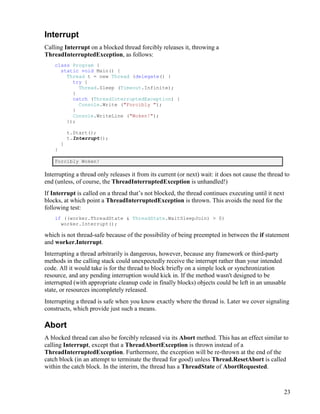
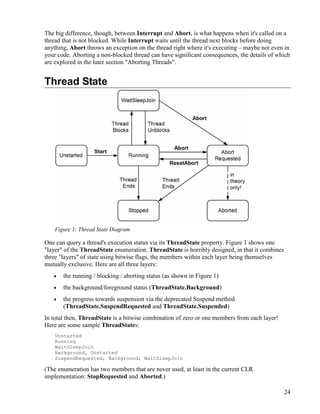
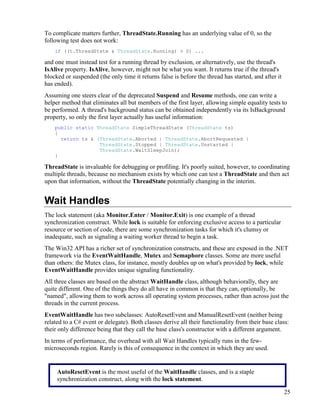

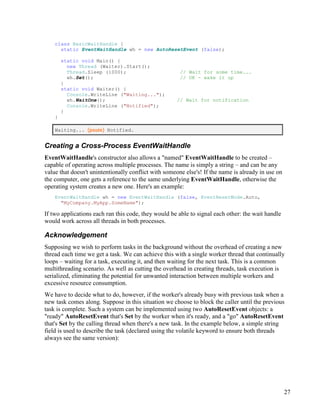
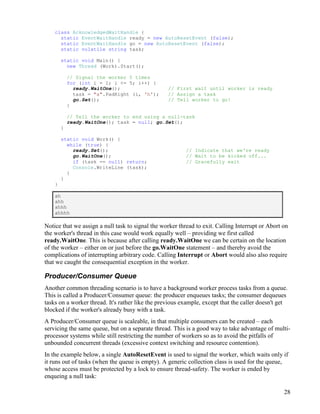
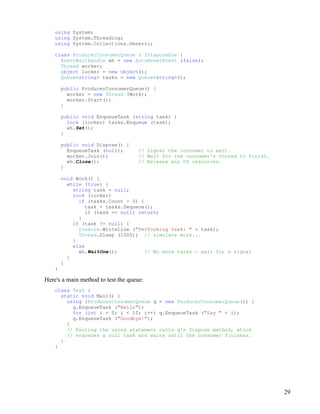
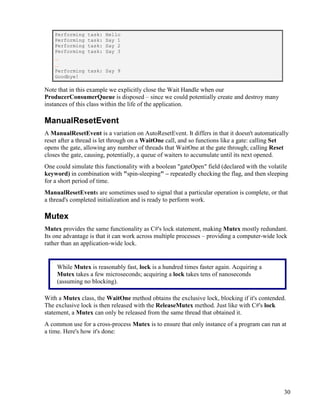
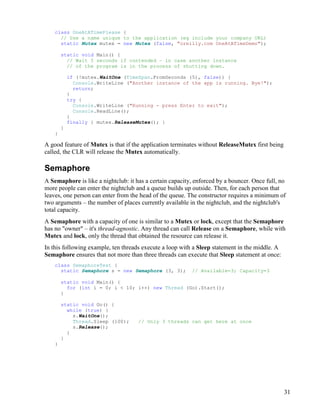
![32
WaitAny, WaitAll and SignalAndWait
In addition to the Set and WaitOne methods, there are static methods on the WaitHandle class
to crack more complex synchronization nuts.
The WaitAny, WaitAll and SignalAndWait methods facilitate waiting across multiple Wait
Handles, potentially of differing types.
SignalAndWait is perhaps the most useful: it calls WaitOne on one WaitHandle, while calling
Set on another WaitHandle – in an atomic operation. One can use method this on a pair of
EventWaitHandles to set up two threads so they "meet" at the same point in time, in a textbook
fashion. Either AutoResetEvent or ManualResetEvent will do the trick. The first thread does
the following:
WaitHandle.SignalAndWait (wh1, wh2);
while the second thread does the opposite:
WaitHandle.SignalAndWait (wh2, wh1);
WaitHandle.WaitAny waits for any one of an array of wait handles; WaitHandle.WaitAll
waits on all of the given handles. Using the ticket turnstile analogy, these methods are like
simultaneously queuing at all the turnstiles – going through at the first one to open (in the case of
WaitAny), or waiting until they all open (in the case of WaitAll).
WaitAll is actually of dubious value because of a weird connection to apartment threading – a
throwback from the legacy COM architecture. WaitAll requires that the caller be in a multi-
threaded apartment – which happens to be the apartment model least suitable for interoperability
– particularly for Windows Forms applications, which need to perform tasks as mundane as
interacting with the clipboard!
Fortunately, the .NET framework provides a more advanced signaling mechanism for when Wait
Handles are awkward or unsuitable – Monitor.Wait and Monitor.Pulse.
Synchronization Contexts
Rather than locking manually, one can lock declaratively. By deriving from
ContextBoundObject and applying the Synchronization attribute, one instructs the CLR to
apply locking automatically. Here's an example:
using System;
using System.Threading;
using System.Runtime.Remoting.Contexts;
[Synchronization]
public class AutoLock : ContextBoundObject {
public void Demo() {
Console.Write ("Start...");
Thread.Sleep (1000); // We can't be preempted here
Console.WriteLine ("end"); // thanks to automatic locking!
}
}](https://image.slidesharecdn.com/threadingincsharp-160921154623/85/Threading-in-c_sharp-32-320.jpg)
![33
public class Test {
public static void Main() {
AutoLock safeInstance = new AutoLock();
new Thread (safeInstance.Demo).Start(); // Call the Demo
new Thread (safeInstance.Demo).Start(); // method 3 times
safeInstance.Demo(); // concurrently.
}
}
Start... end
Start... end
Start... end
The CLR ensures that only one thread can execute code in safeInstance at a time. It does this by
creating a single synchronizing object – and locking it around every call to each of safeInstance's
methods or properties. The scope of the lock – in this case – the safeInstance object – is called a
synchronization context.
So, how does this work? A clue is in the Synchronization attribute's namespace:
System.Runtime.Remoting.Contexts. A ContextBoundObject can be thought of as a "remote"
object – meaning all method calls are intercepted. To make this interception possible, when we
instantiate AutoLock, the CLR actually returns a proxy – an object with the same methods and
properties of an AutoLock object, which acts as an intermediary. It's via this intermediary that
the automatic locking takes place. Overall, the interception adds around a microsecond to each
method call.
The locking is applied internally in the same way. You might expect that the following example
will yield the same result as the last:
[Synchronization]
public class AutoLock : ContextBoundObject {
public void Demo() {
Console.Write ("Start...");
Thread.Sleep (1000);
Console.WriteLine ("end");
}
public void Test() {
new Thread (Demo).Start();
new Thread (Demo).Start();
new Thread (Demo).Start();
Console.ReadLine();
}
public static void Main() {
new AutoLock().Test();
}
}
(Notice that we've sneaked in a Console.ReadLine statement). Because only one thread can
execute code at a time in an object of this class, the three new threads will remain blocked at the
Automatic synchronization cannot be used to protect static type members, nor classes
not derived from ContextBoundObject (for instance, a Windows Form).](https://image.slidesharecdn.com/threadingincsharp-160921154623/85/Threading-in-c_sharp-33-320.jpg)
![34
Demo method until the Test method finishes – which requires the ReadLine to complete. Hence
we end up with the same result as before, but only after pressing the Enter key. This is a thread-
safety hammer almost big enough to preclude any useful multithreading within a class!
Furthermore, we haven't solved a problem described earlier: if AutoLock were a collection class,
for instance, we'd still require a lock around a statement such as the following, assuming it ran
from another class:
if (safeInstance.Count > 0) safeInstance.RemoveAt (0);
unless this code's class was itself a synchronized ContextBoundObject!
A synchronization context can extend beyond the scope of a single object. By default, if a
synchronized object is instantiated from within the code of another, both share the same context
(in other words, one big lock!) This behavior can be changed by specifying an integer flag in
Synchronization attribute's constructor, using one of the constants defined in the
SynchronizationAttribute class:
Constant Meaning
NOT_SUPPORTED Equivalent to not using the Synchronized attribute
SUPPORTED Joins the existing synchronization context if instantiated from another
synchronized object, otherwise remains unsynchronized
REQUIRED
(default)
Joins the existing synchronization context if instantiated from another
synchronized object, otherwise creates a new context
REQUIRES_NEW Always creates a new synchronization context
So if object of class SynchronizedA instantiates an object of class SynchronizedB, they'll be given
separate synchronization contexts if SynchronizedB is declared as follows:
[Synchronization (SynchronizationAttribute.REQUIRES_NEW)]
public class SynchronizedB : ContextBoundObject { ...
The bigger the scope of a synchronization context, the easier it is to manage, but the less the
opportunity for useful concurrency. At the other end of the scale, separate synchronization
contexts invite deadlocks. Here's an example:
[Synchronization]
public class Deadlock : ContextBoundObject {
public DeadLock Other;
public void Demo() { Thread.Sleep (1000); Other.Hello(); }
void Hello() { Console.WriteLine ("hello"); }
}
public class Test {
static void Main() {
Deadlock dead1 = new Deadlock();
Deadlock dead2 = new Deadlock();
dead1.Other = dead2;
dead2.Other = dead1;
new Thread (dead1.Demo).Start();
dead2.Demo();
}
}](https://image.slidesharecdn.com/threadingincsharp-160921154623/85/Threading-in-c_sharp-34-320.jpg)
![35
Because each instance of Deadlock is created within Test – an unsynchronized class – each
instance will gets its own synchronization context, and hence, its own lock. When the two objects
call upon each other, it doesn't take long for the deadlock to occur (one second, to be precise!)
The problem would be particularly insidious if the Deadlock and Test classes were written by
different programming teams. It may be unreasonable to expect those responsible for the Test
class to be even aware of their transgression, let alone know how to go about resolving it. This is
in contrast to explicit locks, where deadlocks are usually more obvious.
Reentrancy
A thread-safe method is sometimes called reentrant, because it can be preempted part way
through its execution, and then called again on another thread without ill effect. In a general
sense, the terms thread-safe and reentrant are considered either synonymous or closely related.
Reentrancy, however, has another more sinister connotation in automatic locking regimes. If the
Synchronization attribute is applied with the reentrant argument true:
[Synchronization(true)]
then the synchronization context's lock will be temporarily released when execution leaves the
context. In the previous example, this would prevent the deadlock from occurring; obviously
desirable. However, a side effect is that during this interim, any thread is free to call any method
on the original object ("re-entering" the synchronization context) and unleashing the very
complications of multithreading one is trying to avoid in the first place. This is the problem of
reentrancy.
While reentrancy can be dangerous, there are sometimes few other options. For instance, suppose
one was to implement multithreading internally within a synchronized class, by delegating the
logic to workers running objects in separate contexts. These workers may be unreasonably
hindered in communicating with each other or the original object without reentrancy.
This highlights a fundamental weakness with automatic synchronization: the extensive scope
over which locking is applied can actually manufacture difficulties that may never have otherwise
arisen. These difficulties – deadlocking, reentrancy, and emasculated concurrency – can make
manual locking more palatable in anything other than simple scenarios.
© 2006-2007, O'Reilly Media, Inc. All rights reserved
Because [Synchronization(true)] is applied at a class-level, this attribute turns every
out-of-context method call made by the class into a Trojan for reentrancy.](https://image.slidesharecdn.com/threadingincsharp-160921154623/85/Threading-in-c_sharp-35-320.jpg)
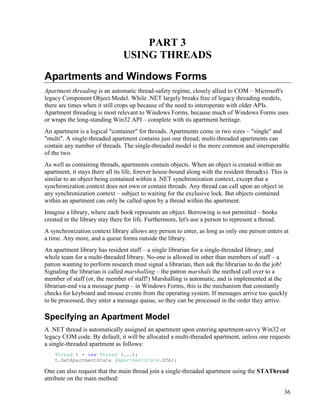
![37
class Program {
[STAThread]
static void Main() {
...
Apartments have no effect while executing pure .NET code. In other words, two threads with an
apartment state of STA can simultaneously call the same method on the same object, and no
automatic marshalling or locking will take place. Only when execution hits unmanaged code can
they kick in.
The types in the System.Windows.Forms namespace extensively call Win32 code designed to
work in a single-threaded apartment. For this reason, a Windows Forms program should have
have the [STAThread] attribute on its main method, otherwise one of two things will occur upon
reaching Win32 UI code:
• it will marshal over to a single-threaded apartment
• it will crash
Control.Invoke
In a multi-threaded Windows Forms application, it's illegal to call a method or property on a
control from any thread other than the one that created it. All cross-thread calls must be explicitly
marshalled to the thread that created the control (usually the main thread), using the
Control.Invoke or Control.BeginInvoke method. One cannot rely on automatic marshalling
because it takes place too late – only when execution gets well into unmanaged code, by which
time plenty of internal .NET code may already have run on the "wrong" thread – code which is
not thread-safe.
An excellent solution to managing worker threads in Windows Forms and WPF applications is to
use BackgroundWorker. This class wraps worker threads that need to report progress and
completion, and automatically calls Control.Invoke or Dispatcher.Invoke as required.
BackgroundWorker
BackgroundWorker is a helper class in the System.ComponentModel namespace for
managing a worker thread. It provides the following features:
• A "cancel" flag for signaling a worker to end without using Abort
• A standard protocol for reporting progress, completion and cancellation
• An implementation of IComponent allowing it be sited in the Visual Studio Designer
• Exception handling on the worker thread
• The ability to update Windows Forms and WPF controls in response to worker
WPF is similar to Windows Forms in that elements can be accessed only from the
thread that originally created them. The equivalent to Control.Invoke in WPF is
Dispatcher.Invoke.](https://image.slidesharecdn.com/threadingincsharp-160921154623/85/Threading-in-c_sharp-37-320.jpg)
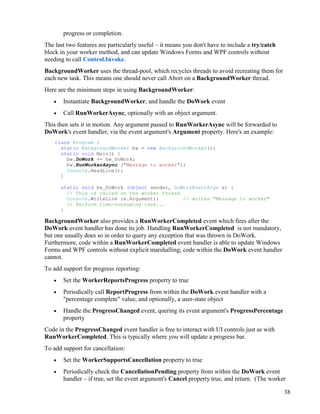

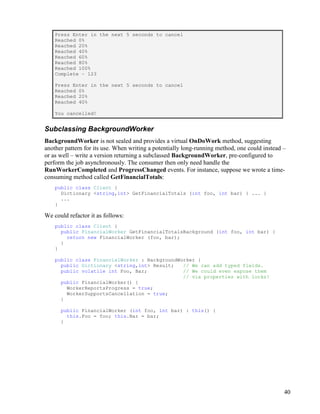
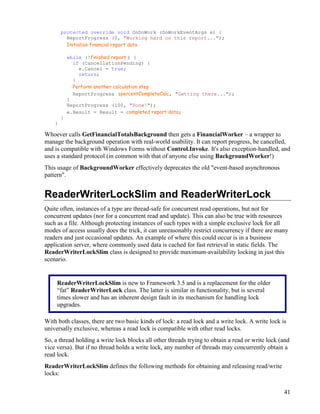
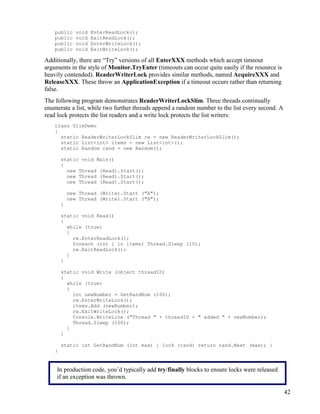
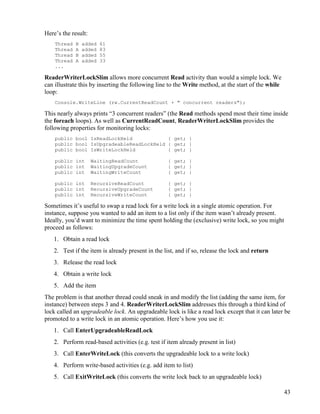
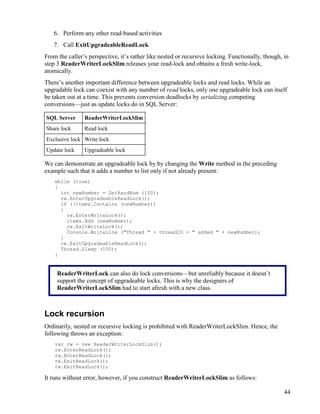

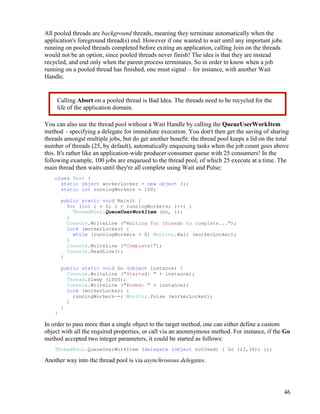
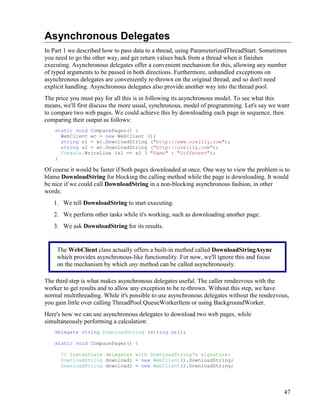
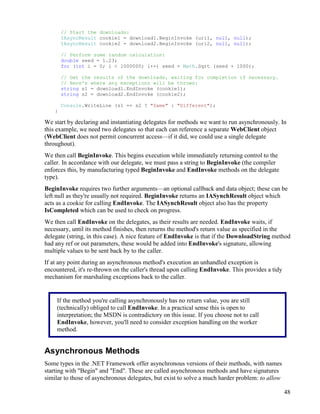
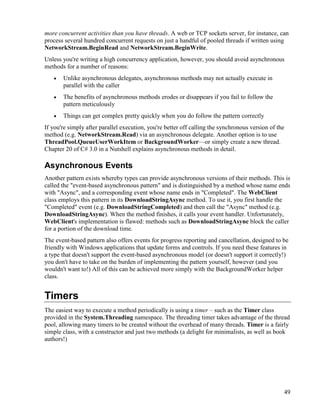
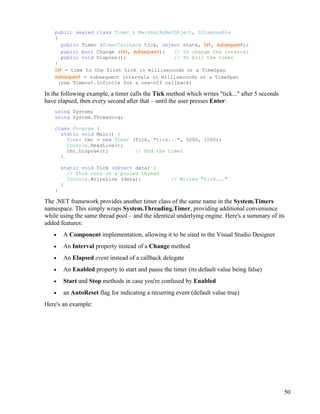
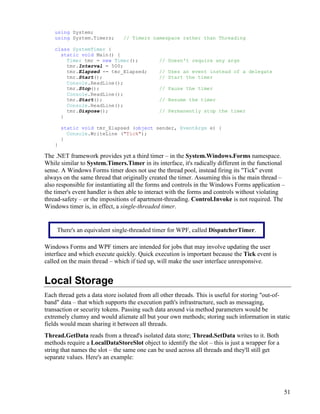
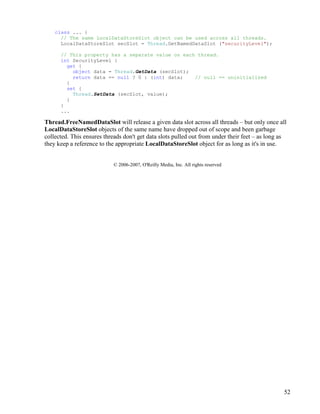
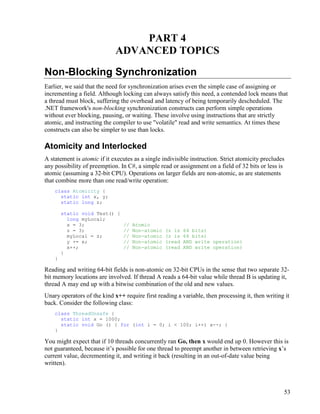
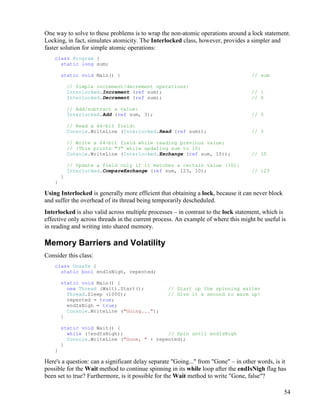
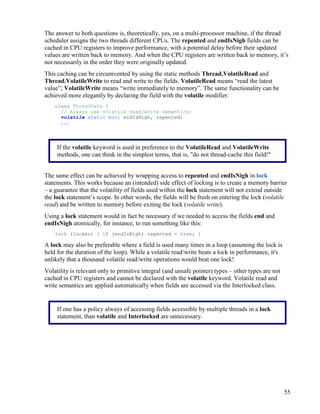
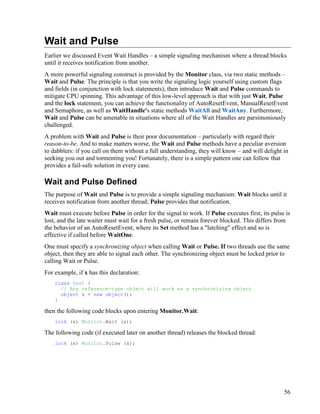
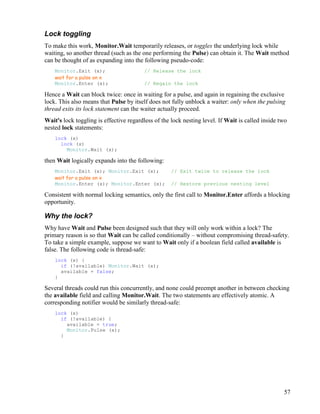
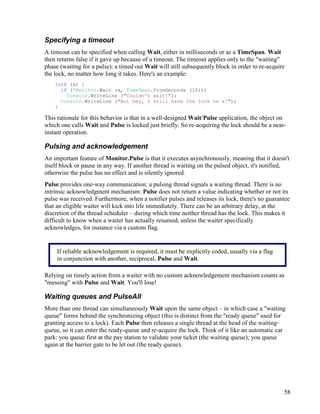
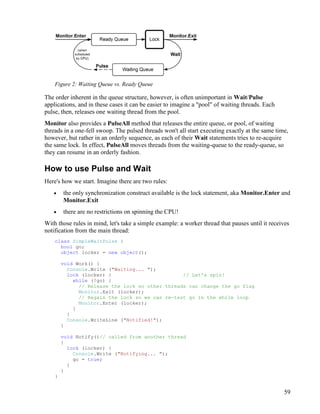
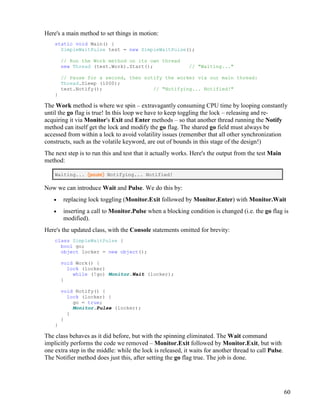

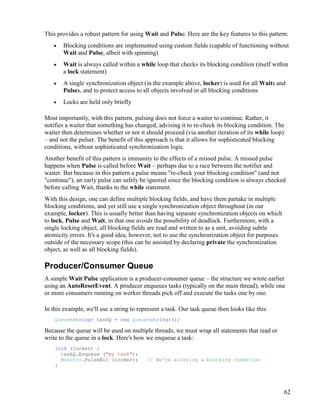
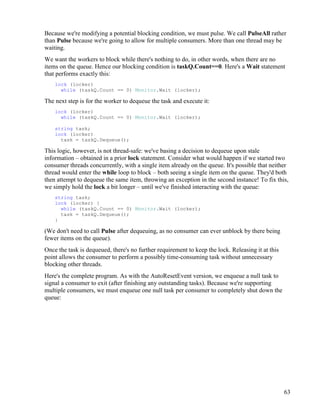
![64
Wait/Pulse Boilerplate #2: Producer/Consumer Queue
using System;
using System.Threading;
using System.Collections.Generic;
public class TaskQueue : IDisposable {
object locker = new object();
Thread[] workers;
Queue<string> taskQ = new Queue<string>();
public TaskQueue (int workerCount) {
workers = new Thread [workerCount];
// Create and start a separate thread for each worker
for (int i = 0; i < workerCount; i++)
(workers [i] = new Thread (Consume)).Start();
}
public void Dispose() {
// Enqueue one null task per worker to make each exit.
foreach (Thread worker in workers) EnqueueTask (null);
foreach (Thread worker in workers) worker.Join();
}
public void EnqueueTask (string task) {
lock (locker) {
taskQ.Enqueue (task);
Monitor.PulseAll (locker);
}
}
void Consume() {
while (true) {
string task;
lock (locker) {
while (taskQ.Count == 0) Monitor.Wait (locker);
task = taskQ.Dequeue();
}
if (task == null) return; // This signals our exit
Console.Write (task);
Thread.Sleep (1000); // Simulate time-consuming task
}
}
}
Here's a Main method that starts a task queue, specifying two concurrent consumer threads, and
then enqueues ten tasks to be shared amongst the two consumers:
static void Main() {
using (TaskQueue q = new TaskQueue (2)) {
for (int i = 0; i < 10; i++)
q.EnqueueTask (" Task" + i);
Console.WriteLine ("Enqueued 10 tasks");
Console.WriteLine ("Waiting for tasks to complete...");
}
// Exiting the using statement runs TaskQueue's Dispose method, which
// shuts down the consumers, after all outstanding tasks are completed.
Console.WriteLine ("rnAll tasks done!");
}](https://image.slidesharecdn.com/threadingincsharp-160921154623/85/Threading-in-c_sharp-64-320.jpg)
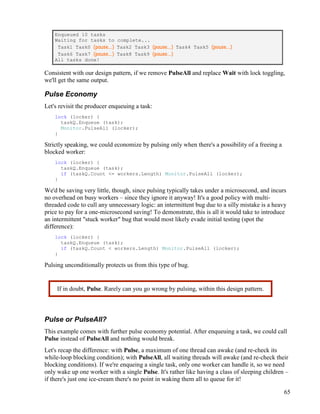

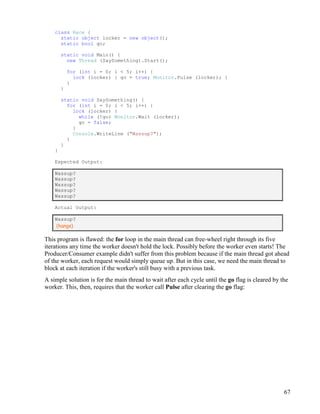
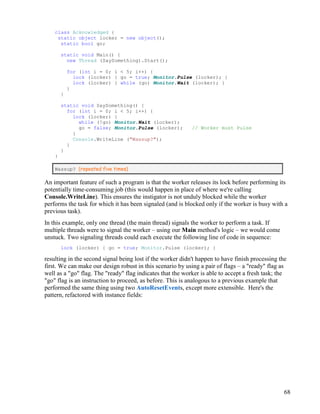
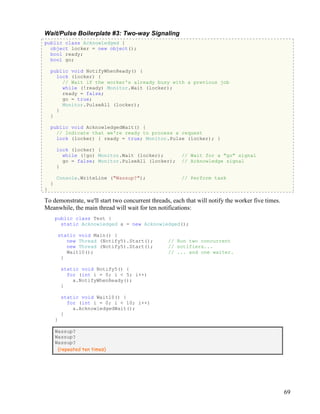


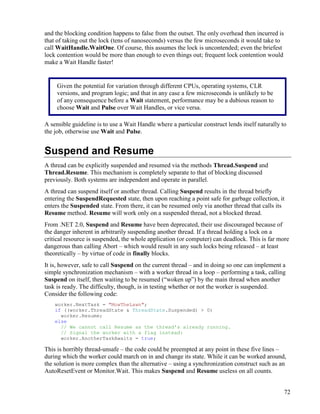

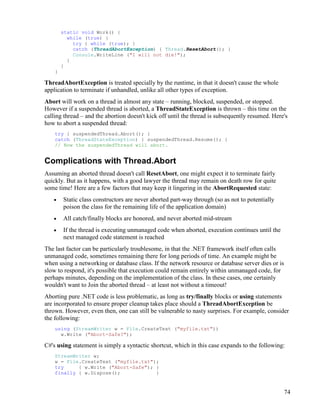
![75
It's possible for an Abort to fire after the StreamWriter is created, but before the try block
begins. In fact, by digging into the IL, one can see that it's also possible for it to fire in between
the StreamWriter being created and assigned to w:
IL_0001: ldstr "myfile.txt"
IL_0006: call class [mscorlib]System.IO.StreamWriter
[mscorlib]System.IO.File::CreateText(string)
IL_000b: stloc.0
.try
{
...
Either way, the Dispose method in the finally block is circumvented, resulting in an abandoned
open file handle – preventing any subsequent attempts to create myfile.txt until the application
domain ends.
In reality, the situation in this example is worse still, because an Abort would most likely take
place within the implementation of File.CreateText. This is referred to as opaque code – that
which we don't have the source. Fortunately, .NET code is never truly opaque: we can again
wheel in ILDASM, or better still, Lutz Roeder's Reflector – and looking into the framework's
assemblies, see that it calls StreamWriter's constructor, which has the following logic:
public StreamWriter (string path, bool append, ...)
{
...
...
Stream stream1 = StreamWriter.CreateFile (path, append);
this.Init (stream1, ...);
}
Nowhere in this constructor is there a try/catch block, meaning that if the Abort fires anywhere
within the (non-trivial) Init method, the newly created stream will be abandoned, with no way of
closing the underlying file handle.
Because disassembling every required CLR call is obviously impractical, this raises the question
on how one should go about writing an abort-friendly method. The most common workaround is
not to abort another thread at all – but rather add a custom boolean field to the worker's class,
signaling that it should abort. The worker checks the flag periodically, exiting gracefully if true.
Ironically, the most graceful exit for the worker is by calling Abort on its own thread – although
explicitly throwing an exception also works well. This ensures the thread's backed right out,
while executing any catch/finally blocks – rather like calling Abort from another thread, except
the exception is thrown only from designated places:
class ProLife {
public static void Main() {
RulyWorker w = new RulyWorker();
Thread t = new Thread (w.Work);
t.Start();
Thread.Sleep (500);
w.Abort();
}](https://image.slidesharecdn.com/threadingincsharp-160921154623/85/Threading-in-c_sharp-75-320.jpg)
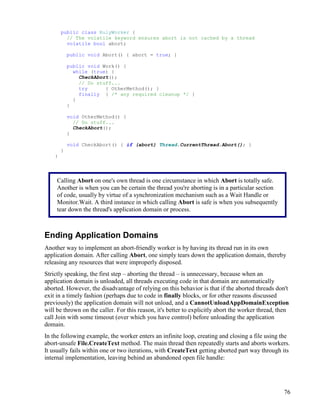
![77
using System;
using System.IO;
using System.Threading;
class Program {
static void Main() {
while (true) {
Thread t = new Thread (Work);
t.Start();
Thread.Sleep (100);
t.Abort();
Console.WriteLine ("Aborted");
}
}
static void Work() {
while (true)
using (StreamWriter w = File.CreateText ("myfile.txt")) { }
}
}
Aborted
Aborted
IOException: The process cannot access the file 'myfile.txt' because it
is being used by another process.
Here's the same program modified so the worker thread runs in its own application domain,
which is unloaded after the thread is aborted. It runs perpetually without error, because unloading
the application domain releases the abandoned file handle:
class Program {
static void Main (string [] args) {
while (true) {
AppDomain ad = AppDomain.CreateDomain ("worker");
Thread t = new Thread (delegate() { ad.DoCallBack (Work); });
t.Start();
Thread.Sleep (100);
t.Abort();
if (!t.Join (2000)) {
// Thread won't end - here's where we could take further action,
// if, indeed, there was anything we could do. Fortunately in
// this case, we can expect the thread *always* to end.
}
AppDomain.Unload (ad); // Tear down the polluted domain!
Console.WriteLine ("Aborted");
}
}
static void Work() {
while (true)
using (StreamWriter w = File.CreateText ("myfile.txt")) { }
}
}
Aborted
Aborted
Aborted
Aborted
...
...](https://image.slidesharecdn.com/threadingincsharp-160921154623/85/Threading-in-c_sharp-77-320.jpg)
